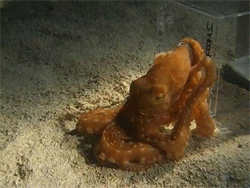Timbuktu Was A Center Of The Manuscript Trade, With Traders Bringing Islamic Texts From All Over The


Timbuktu was a center of the manuscript trade, with traders bringing Islamic texts from all over the Muslim world. Despite occupations and invasions of all kinds since then, scholars managed to preserve and even restore hundreds of thousands of manuscripts dating from the 13th century.
But that changed when militant Islamists backed by al-Qaida arrived in 2012.
The Bad-Ass Librarians of Timbuktu tells the story of librarian Abdel Kader Haidara, who organized and oversaw a secret plot to smuggle hundreds of thousands of medieval manuscripts out of Timbuktu before they could be destroyed by Islamist rebels.
Hear author Joshua Hammer tell the story here.
– Petra
More Posts from Philosophical-amoeba and Others


Plantigrade vs. Digitigrade Carnivores - the Polar Bear and the African Lion
The foot structure of many animals plays a critical role in their locomotion and environmental niche, and in carnivores, the clear distinction between plantigrade (walking with the podials and metatarsals both flat on the ground) and digitigrade (walking on the toes, with the heel and wrist permanently raised) animals is most evident.
In plantigrade beasts - which include humans, many rodents, bears, racoons, and opossums - the larger surface area that the many bones provide can act as both a stabilizer and a very effective bearer of great weights. In fact, the big ol’ flighted dinosaurs were plantigrade. At the same time, so were the first (and relatively small) mammals, since both of them needed lots of stability in their feet. The weight-bearing ability and stable platform comes at the cost of speed, as the energy and requirements for movement of so many bones and muscles is much greater than digitigrade feet or unguligrade feet.
Digitigrade animals walk on only their toes, leaving their wrists and ankles permanently raised. This affords more speed, much more silent movement. Cats, birds, and dogs are digitigrade. Digitigrade feet evolved long after plantigrade feet, to fit the niche of mid-sized carnivores. However, they cannot effectively sustain large loads, which is why you cannot use a lion as a pack mule. Well, among other reasons. Really, you just don’t want to try using any mid-sized (or large, in the lion’s case) carnivore as a pack mule.
On the Anatomy of Vertebrates. Richard Owen, 1866.


On this day, 29th April 1770, Captain James Cook first landed at Botany Bay, (Sydney, Australia).
James Cook, with Joseph Banks and Daniel Solander landed at Kurnell in the afternoon of April 29th 1770, in search of fresh water. In the next few days, excursions around the bay were undertaken and samples of native flora collected, which proved so plentiful that Cook named the area Botany Bay.
The State Library of New South Wales holds many items relating to this voyage of the Endeavour, including Joseph Banks Journal and a copy of James Cook’s Endeavour log.
Portrait of Captain James Cook / painted by Sir Nathaniel Dance. Engraved by Cosmo Armstrong. State Library of New South Wales.
A Journal of the proceedings of His Majesty’s Bark Endeavour on a voyage round the world, by Lieutenant James Cook, Commander, commencing the 25th of May 1768 - 23 Oct. 1770 - Entrance of Endeavour River and Botany Bay Maps




On this date in 1884, the first edition of what would become the Oxford English Dictionary was published under the name A New English Dictionary on Historical Principles; Founded Mainly on the Materials Collected by The Philological Society. Research for the OED had begun in 1857, when the Philological Society in London established an “Unregistered Words Committee” to find words that were either poorly defined, or absent from contemporary dictionaries. When the list of unregistered words outnumbered the amount of words found in nineteenth-century dictionaries, the group decided to write their own. The Oxford University Press agreed to publish the dictionary in 1879, and the group published the first fascicle – which covered A to Ant –in 1884 to disappointing sales. It wasn’t until 1928 that the final fascicle was published, totaling 128 fascicles in total.
In 1933, a thirteen-volume set including all fascicles and a one-volume supplement went on sale under its current name: Oxford English Dictionary – only seventy-six years in the making!
Pictured above is our well-loved copy of that historic first fascicle, which includes the preface to the dictionary and entries A through Ant. While the volume is huge and a little intimidating, it was only the beginning to what would become the most comprehensive dictionary in the English language.
Ed. James A.H. Murray. A New English Dictionary on Historical Principles; Founded Mainly on the Materials Collected by The Philological Society v. 1. Oxford: Clarendon Press, 1888. 423 M96 v. 1.
Don’t play, play - Singlish is studied around the globe
Blogger Wendy Cheng’s Web video series Xiaxue’s Guide To Life and Jack Neo’s Ah Boys To Men film franchise are well-known shows among Singaporeans. For one thing, they are filled with colloquial terms, local references and copious doses of Singlish terms such as “lah” and “lor”.
But they are not merely for entertainment. In recent years, such shows have found a place in universities around the world, where linguists draw on dialogues used in these local productions to introduce to undergraduates and postgraduate students how Singlish has become a unique variety of the English language.
This comes even as concerns have been raised over how Singlish could impede the use of standard English here.
From Italy and Germany to Japan, at least seven universities around the world have used Singlish as a case study in linguistics courses over the past decade. This is on top of more than 40 academics outside of Singapore - some of whom were previously based here - who have written books or papers on Singlish as part of their research.

How Humans Change Space Itself
It’s no surprise that humans influence the surface of our planet, but our reach can go farther than that. Humans affect space, too.

We know storms from the sun can naturally change the space environment around Earth, which can have an impact on satellites and power grids.

Scientists now know that Cold War era nuclear tests in the 1950s caused similar effects.
Particles around Earth are organized into layers known as radiation belts. These 1950s tests created a temporary extra layer of radiation closer to Earth.

The effects of this could be seen all around the world. Aurora appeared at the equator instead of the poles, utility grids in Hawaii were strained, and in some cases, satellites above test sites were affected.

Some types of communications signals can also affect Earth’s radiation belts.
Very low-frequency waves, or VLFs, are used for radio communications. They are often used to communicate with submarines, because these waves can penetrate deep into the ocean.

The waves can also travel far into the space environment around Earth. When these waves are in space, they affect how high-energy particles move, creating a barrier against natural radiation.

The outer edge of this radio-wave barrier corresponds almost exactly the inner edge of Earth’s natural radiation belts – meaning it could be human activity that at least partly shapes this natural radiation around Earth.

For more NASA sun and space research, visit www.nasa.gov/sunearth and follow us on Twitter and Facebook.
Make sure to follow us on Tumblr for your regular dose of space: http://nasa.tumblr.com
The Cuban Missile Crisis
At this time in 1962, the U.S. was in the thick of the Cuban Missile Crisis. Here’s a brief recap of what exactly happened during those thirteen days.

It’s not hard to imagine a world where at any given moment, you and everyone you know could be wiped out without warning at the push of a button. This was the reality for millions of people during the 45-year period after World War II, now known as the Cold War. As the United States and Soviet Union faced off across the globe, each knew that the other had nuclear weapons capable of destroying it. And destruction never loomed closer than during the 13 days of the Cuban Missile Crisis.

In 1961, the U.S. unsuccessfully tried to overthrow Cuba’s new communist government. That failed attempt was known as the Bay of Pigs, and it convinced Cuba to seek help from the U.S.S.R. Soviet premier Nikita Khrushchev was happy to comply by secretly deploying nuclear missiles to Cuba, not only to protect the island, but to counteract the threat from U.S. missiles in Italy and Turkey. By the time U.S. intelligence discovered the plan, the materials to create the missiles were already in place.

At an emergency meeting on October 16, 1962, military advisors urged an airstrike on missile sites and invasion of the island. But President John F. Kennedy chose a more careful approach. On October 22, he announced that the the U.S. Navy would intercept all shipments to Cuba, but a naval blockade was considered an act of war. Although the President called it a quarantine that did not block basic necessities, the Soviets didn’t appreciate the distinction.

Thus ensued the most intense six days of the Cold War. As the weapons continued to be armed, the U.S. prepared for a possible invasion. For the first time in history, the U.S. Military set itself to DEFCON 2, the defense readiness one step away from nuclear war. With hundreds of nuclear missiles ready to launch, the metaphorical Doomsday Clock stood at one minute to midnight.
But diplomacy carried on. In Washington, D.C., Attorney General Robert Kennedy secretly met with Soviet Ambassador Anatoly Dobrynin. After intense negotiation, they reached the following proposal. The U.S. would remove their missiles from Turkey and Italy and promise to never invade Cuba in exchange for the Soviet withdrawal from Cuba under U.N. inspection. The crisis was now over.

While criticized at the time by their respective governments for bargaining with the enemy, contemporary historical analysis shows great admiration for Kennedy’s and Khrushchev’s ability to diplomatically solve the crisis. Overall, the Cuban Missile Crisis revealed just how fragile human politics are compared to the terrifying power they can unleash.
For a deeper dive into the circumstances of the Cuban Missile Crisis, be sure to watch The history of the Cuban Missile Crisis - Matthew A. Jordan
Animation by Patrick Smith
Survivorship Bias
I have posted about survivorship bias and how it affects your career choices: how a Hollywood actor giving the classic “follow your dreams and never give up” line is bad advice and is pure survivorship bias at work.
When I read up on the wikipedia page, I encountered an interesting story:
During WWII the US Air Force wanted to minimize bomber losses to enemy fire. The Center for Naval Analyses ran a research on where bombers tend to get hit with the explicit aim of enforcing the parts of the airframe that is most likely to receive incoming fire. This is what they came up with:

So, they said: the red dots are where bombers are most likely to be hit, so put some more armor on those parts to make the bombers more resilient. That looked like a logical conclusion, until Abraham Wald - a mathematician - started asking questions:
- how did you obtain that data? - well, we looked at every bomber returning from a raid, marked the damages on the airframe on a sheet and collected the sheets from all allied air bases over months. What you see is the result of hundreds of those sheets. - and your conclusion? - well, the red dots are where the bombers were hit. So let’s enforce those parts because they are most exposed to enemy fire. - no. the red dots are where a bomber can take a hit and return. The bombers that took a hit to the ailerons, the engines or the cockpit never made it home. That’s why they are absent in your data. The blank spots are exactly where you have to enforce the airframe, so those bombers can return.
This is survivorship bias. You only see a subset of the outcomes. The ones that made it far enough to be visible. Look out for absence of data. Sometimes they tell a story of their own.
BTW: You can see the result of this research today. This is the exact reason the A-10 has the pilot sitting in a titanium armor bathtub and has it’s engines placed high and shielded.
im putting together a couple of scottish folk mixes bc that’s what i do and im honestly curious if anyone in my country has ever been unequivocally happy about anything ever

FAMOUS AUTHORS
Classic Bookshelf: This site has put classic novels online, from Charles Dickens to Charlotte Bronte.
The Online Books Page: The University of Pennsylvania hosts this book search and database.
Project Gutenberg: This famous site has over 27,000 free books online.
Page by Page Books: Find books by Sir Arthur Conan Doyle and H.G. Wells, as well as speeches from George W. Bush on this site.
Classic Book Library: Genres here include historical fiction, history, science fiction, mystery, romance and children’s literature, but they’re all classics.
Classic Reader: Here you can read Shakespeare, young adult fiction and more.
Read Print: From George Orwell to Alexandre Dumas to George Eliot to Charles Darwin, this online library is stocked with the best classics.
Planet eBook: Download free classic literature titles here, from Dostoevsky to D.H. Lawrence to Joseph Conrad.
The Spectator Project: Montclair State University’s project features full-text, online versions of The Spectator and The Tatler.
Bibliomania: This site has more than 2,000 classic texts, plus study guides and reference books.
Online Library of Literature: Find full and unabridged texts of classic literature, including the Bronte sisters, Mark Twain and more.
Bartleby: Bartleby has much more than just the classics, but its collection of anthologies and other important novels made it famous.
Fiction.us: Fiction.us has a huge selection of novels, including works by Lewis Carroll, Willa Cather, Sherwood Anderson, Flaubert, George Eliot, F. Scott Fitzgerald and others.
Free Classic Literature: Find British authors like Shakespeare and Sir Arthur Conan Doyle, plus other authors like Jules Verne, Mark Twain, and more.
TEXTBOOKS
Textbook Revolution: Find biology, business, engineering, mathematics and world history textbooks here.
Wikibooks: From cookbooks to the computing department, find instructional and educational materials here.
KnowThis Free Online Textbooks: Get directed to stats textbooks and more.
Online Medical Textbooks: Find books about plastic surgery, anatomy and more here.
Online Science and Math Textbooks: Access biochemistry, chemistry, aeronautics, medical manuals and other textbooks here.
MIT Open Courseware Supplemental Resources: Find free videos, textbooks and more on the subjects of mechanical engineering, mathematics, chemistry and more.
Flat World Knowledge: This innovative site has created an open college textbooks platform that will launch in January 2009.
Free Business Textbooks: Find free books to go along with accounting, economics and other business classes.
Light and Matter: Here you can access open source physics textbooks.
eMedicine: This project from WebMD is continuously updated and has articles and references on surgery, pediatrics and more.
MATH AND SCIENCE
FullBooks.com: This site has “thousands of full-text free books,” including a large amount of scientific essays and books.
Free online textbooks, lecture notes, tutorials and videos on mathematics: NYU links to several free resources for math students.
Online Mathematics Texts: Here you can find online textbooks likeElementary Linear Algebra and Complex Variables.
Science and Engineering Books for free download: These books range in topics from nanotechnology to compressible flow.
FreeScience.info: Find over 1800 math, engineering and science books here.
Free Tech Books: Computer programmers and computer science enthusiasts can find helpful books here.
CHILDREN’S BOOKS
byGosh: Find free illustrated children’s books and stories here.
Munseys: Munseys has nearly 2,000 children’s titles, plus books about religion, biographies and more.
International Children’s Digital Library: Find award-winning books and search by categories like age group, make believe books, true books or picture books.
Lookybook: Access children’s picture books here.
PHILOSOPHY AND RELIGION
Bored.com: Bored.com has music ebooks, cooking ebooks, and over 150 philosophy titles and over 1,000 religion titles.
Ideology.us: Here you’ll find works by Rene Descartes, Sigmund Freud, Karl Marx, David Hume and others.
Free Books on Yoga, Religion and Philosophy: Recent uploads to this site include Practical Lessons in Yoga and Philosophy of Dreams.
The Sociology of Religion: Read this book by Max Weber, here.
Religion eBooks: Read books about the Bible, Christian books, and more.
PLAYS
ReadBookOnline.net: Here you can read plays by Chekhov, Thomas Hardy, Ben Jonson, Shakespeare, Edgar Allan Poe and others.
Plays: Read Pygmalion, Uncle Vanya or The Playboy of the Western World here.
The Complete Works of William Shakespeare: MIT has made available all of Shakespeare’s comedies, tragedies, and histories.
Plays Online: This site catalogs “all the plays [they] know about that are available in full text versions online for free.”
ProPlay: This site has children’s plays, comedies, dramas and musicals.
MODERN FICTION, FANTASY AND ROMANCE
Public Bookshelf: Find romance novels, mysteries and more.
The Internet Book Database of Fiction: This forum features fantasy and graphic novels, anime, J.K. Rowling and more.
Free Online Novels: Here you can find Christian novels, fantasy and graphic novels, adventure books, horror books and more.
Foxglove: This British site has free novels, satire and short stories.
Baen Free Library: Find books by Scott Gier, Keith Laumer and others.
The Road to Romance: This website has books by Patricia Cornwell and other romance novelists.
Get Free Ebooks: This site’s largest collection includes fiction books.
John T. Cullen: Read short stories from John T. Cullen here.
SF and Fantasy Books Online: Books here include Arabian Nights,Aesop’s Fables and more.
Free Novels Online and Free Online Cyber-Books: This list contains mostly fantasy books.
FOREIGN LANGUAGE
Project Laurens Jz Coster: Find Dutch literature here.
ATHENA Textes Francais: Search by author’s name, French books, or books written by other authors but translated into French.
Liber Liber: Download Italian books here. Browse by author, title, or subject.
Biblioteca romaneasca: Find Romanian books on this site.
Bibliolteca Virtual Miguel de Cervantes: Look up authors to find a catalog of their available works on this Spanish site.
KEIMENA: This page is entirely in Greek, but if you’re looking for modern Greek literature, this is the place to access books online.
Proyecto Cervantes: Texas A&M’s Proyecto Cervantes has cataloged Cervantes’ work online.
Corpus Scriptorum Latinorum: Access many Latin texts here.
Project Runeberg: Find Scandinavian literature online here.
Italian Women Writers: This site provides information about Italian women authors and features full-text titles too.
Biblioteca Valenciana: Register to use this database of Catalan and Valencian books.
Ketab Farsi: Access literature and publications in Farsi from this site.
Afghanistan Digital Library: Powered by NYU, the Afghanistan Digital Library has works published between 1870 and 1930.
CELT: CELT stands for “the Corpus of Electronic Texts” features important historical literature and documents.
Projekt Gutenberg-DE: This easy-to-use database of German language texts lets you search by genres and author.
HISTORY AND CULTURE
LibriVox: LibriVox has a good selection of historical fiction.
The Perseus Project: Tufts’ Perseus Digital Library features titles from Ancient Rome and Greece, published in English and original languages.
Access Genealogy: Find literature about Native American history, the Scotch-Irish immigration in the 19th and 20th centuries, and more.
Free History Books: This collection features U.S. history books, including works by Paul Jennings, Sarah Morgan Dawson, Josiah Quincy and others.
Most Popular History Books: Free titles include Seven Days and Seven Nights by Alexander Szegedy and Autobiography of a Female Slave by Martha G. Browne.
RARE BOOKS
Questia: Questia has 5,000 books available for free, including rare books and classics.
ARTS AND ENTERTAINMENT
Books-On-Line: This large collection includes movie scripts, newer works, cookbooks and more.
Chest of Books: This site has a wide range of free books, including gardening and cooking books, home improvement books, craft and hobby books, art books and more.
Free e-Books: Find titles related to beauty and fashion, games, health, drama and more.
2020ok: Categories here include art, graphic design, performing arts, ethnic and national, careers, business and a lot more.
Free Art Books: Find artist books and art books in PDF format here.
Free Web design books: OnlineComputerBooks.com directs you to free web design books.
Free Music Books: Find sheet music, lyrics and books about music here.
Free Fashion Books: Costume and fashion books are linked to the Google Books page.
MYSTERY
MysteryNet: Read free short mystery stories on this site.
TopMystery.com: Read books by Edgar Allan Poe, Sir Arthur Conan Doyle, GK Chesterton and other mystery writers here.
Mystery Books: Read books by Sue Grafton and others.
POETRY
The Literature Network: This site features forums, a copy of The King James Bible, and over 3,000 short stories and poems.
Poetry: This list includes “The Raven,” “O Captain! My Captain!” and “The Ballad of Bonnie and Clyde.”
Poem Hunter: Find free poems, lyrics and quotations on this site.
Famous Poetry Online: Read limericks, love poetry, and poems by Robert Browning, Emily Dickinson, John Donne, Lord Byron and others.
Google Poetry: Google Books has a large selection of poetry, fromThe Canterbury Tales to Beowulf to Walt Whitman.
QuotesandPoem.com: Read poems by Maya Angelou, William Blake, Sylvia Plath and more.
CompleteClassics.com: Rudyard Kipling, Allen Ginsberg and Alfred Lord Tennyson are all featured here.
PinkPoem.com: On this site, you can download free poetry ebooks.
MISC
Banned Books: Here you can follow links of banned books to their full text online.
World eBook Library: This monstrous collection includes classics, encyclopedias, children’s books and a lot more.
DailyLit: DailyLit has everything from Moby Dick to the recent phenomenon, Skinny Bitch.
A Celebration of Women Writers: The University of Pennsylvania’s page for women writers includes Newbery winners.
Free Online Novels: These novels are fully online and range from romance to religious fiction to historical fiction.
ManyBooks.net: Download mysteries and other books for your iPhone or eBook reader here.
Authorama: Books here are pulled from Google Books and more. You’ll find history books, novels and more.
Prize-winning books online: Use this directory to connect to full-text copies of Newbery winners, Nobel Prize winners and Pulitzer winners.
-
 ria-violi liked this · 4 years ago
ria-violi liked this · 4 years ago -
 farendaire liked this · 5 years ago
farendaire liked this · 5 years ago -
 mars-the-menace liked this · 5 years ago
mars-the-menace liked this · 5 years ago -
 crowley-needs-a-hug liked this · 6 years ago
crowley-needs-a-hug liked this · 6 years ago -
 bluethepearldiver reblogged this · 6 years ago
bluethepearldiver reblogged this · 6 years ago -
 coolbooksandqoutes-blog reblogged this · 6 years ago
coolbooksandqoutes-blog reblogged this · 6 years ago -
 thewhyldeone reblogged this · 6 years ago
thewhyldeone reblogged this · 6 years ago -
 thewhyldeone liked this · 6 years ago
thewhyldeone liked this · 6 years ago -
 tout-tourne liked this · 6 years ago
tout-tourne liked this · 6 years ago -
 dricki77atl liked this · 7 years ago
dricki77atl liked this · 7 years ago -
 mykcfu liked this · 7 years ago
mykcfu liked this · 7 years ago -
 maidensapphire-blog liked this · 7 years ago
maidensapphire-blog liked this · 7 years ago -
 wolf-gang-cobain liked this · 7 years ago
wolf-gang-cobain liked this · 7 years ago -
 thebookishgremlin reblogged this · 7 years ago
thebookishgremlin reblogged this · 7 years ago -
 illuminaticodici reblogged this · 7 years ago
illuminaticodici reblogged this · 7 years ago -
 727june liked this · 8 years ago
727june liked this · 8 years ago -
 thelazybookcollector reblogged this · 8 years ago
thelazybookcollector reblogged this · 8 years ago -
 elkbloodheart liked this · 8 years ago
elkbloodheart liked this · 8 years ago -
 elisereadsblog reblogged this · 8 years ago
elisereadsblog reblogged this · 8 years ago -
 gbird37 reblogged this · 9 years ago
gbird37 reblogged this · 9 years ago -
 sahljournal liked this · 9 years ago
sahljournal liked this · 9 years ago -
 tumblyorro liked this · 9 years ago
tumblyorro liked this · 9 years ago -
 youngwms liked this · 9 years ago
youngwms liked this · 9 years ago -
 viendotv liked this · 9 years ago
viendotv liked this · 9 years ago -
 mysteriousmanwiththehat-blog reblogged this · 9 years ago
mysteriousmanwiththehat-blog reblogged this · 9 years ago -
 bigcolorengineer liked this · 9 years ago
bigcolorengineer liked this · 9 years ago -
 perfectspringbaby liked this · 9 years ago
perfectspringbaby liked this · 9 years ago -
 pflibteens reblogged this · 9 years ago
pflibteens reblogged this · 9 years ago -
 azhdarcho reblogged this · 9 years ago
azhdarcho reblogged this · 9 years ago -
 unbearable-lightness-of-ink reblogged this · 9 years ago
unbearable-lightness-of-ink reblogged this · 9 years ago -
 alivastertherealbear liked this · 9 years ago
alivastertherealbear liked this · 9 years ago -
 ztexture-blog liked this · 9 years ago
ztexture-blog liked this · 9 years ago -
 unbearable-lightness-of-ink liked this · 9 years ago
unbearable-lightness-of-ink liked this · 9 years ago -
 hijaiye reblogged this · 9 years ago
hijaiye reblogged this · 9 years ago -
 kaui321 liked this · 9 years ago
kaui321 liked this · 9 years ago -
 scvpubliclib reblogged this · 9 years ago
scvpubliclib reblogged this · 9 years ago -
 snarlfurillo liked this · 9 years ago
snarlfurillo liked this · 9 years ago -
 asjglvhnkvdfgsfdg liked this · 9 years ago
asjglvhnkvdfgsfdg liked this · 9 years ago -
 s0m3-b0dy reblogged this · 9 years ago
s0m3-b0dy reblogged this · 9 years ago -
 roxnap liked this · 9 years ago
roxnap liked this · 9 years ago -
 theaichawave liked this · 9 years ago
theaichawave liked this · 9 years ago -
 theaichawave reblogged this · 9 years ago
theaichawave reblogged this · 9 years ago -
 visionaria liked this · 9 years ago
visionaria liked this · 9 years ago -
 marcustheestallion reblogged this · 9 years ago
marcustheestallion reblogged this · 9 years ago
A reblog of nerdy and quirky stuff that pique my interest.
291 posts







